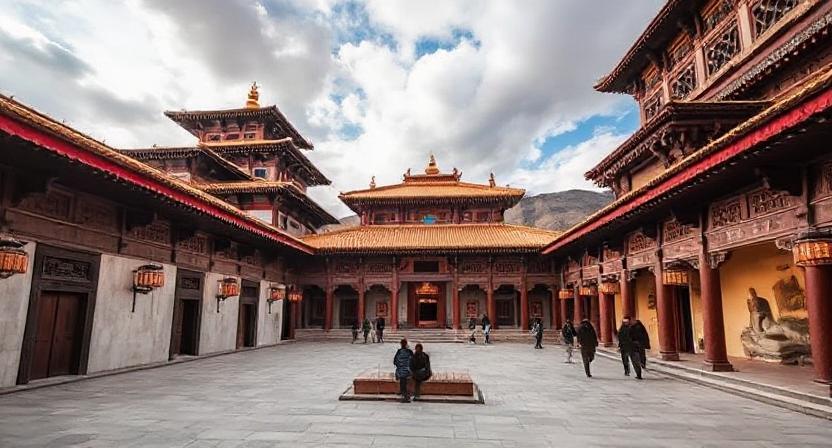
The ancient Jebum-gang Lha-khang Temple in Lhasa, Tibet, has been transformed from centuries-old spiritual and cultural complex and a past granary into the lively contemporary art centre it is today. The project, which restores an important site of cultural and spiritual significance, is also a significant move toward developing sustainable tourism in the area. The transformation enables both local citizens and tourists to be able to experience the rich cultural heritage of Tibet while interacting with current artistic expression, offering a one-of-a-kind cultural tourism experience.
A Cultural and Spiritual Landmark Revived for Modern Audiences
The Jebum-gang Lha-khang Temple, with its history spanning approximately 200 years, features murals from the Qing Dynasty (1644-1911) and stands as an architectural testament to Tibetan heritage. Originally built in the late 19th century, the temple was used for spiritual purposes before being repurposed as a granary. Now, after years of careful restoration, it has been revived as an art center that bridges the old and the new, offering tourists a chance to explore Tibetan history and culture while interacting with modern art forms.
Architect Xia Yujun and his team ensured the preservation of the temple’s original structure while introducing necessary modern upgrades to transform it into a functional space for art exhibitions and cultural events. The restoration process has not only protected the historical murals and fire-damaged carvings but also integrated modern lighting systems and flooring that allow the temple to host museum-grade exhibitions and events without disrupting its spiritual atmosphere.
Tourism Growth Through Cultural and Artistic Innovation
The conversion of the Jebum-gang Lha-khang Temple into an art center presents a unique opportunity for tourism growth in Lhasa and Tibet. By integrating both heritage tourism and modern art, the project draws international visitors looking to experience Tibet’s history while discovering cutting-edge contemporary art. Tibet is already a major draw for spiritual tourists, pilgrims, and those interested in historical exploration, and this transformation enhances the appeal of the region for cultural tourists and art lovers alike.
Through interactive exhibitions and art showcases, the newly transformed temple offers visitors an immersive experience that combines the rich history of Tibet with the vibrancy of modern art. This balance of the traditional and the contemporary gives tourists a deeper understanding of Tibet’s cultural significance while also introducing them to its modern creative scene.
Enhancing Visitor Experiences with Multi-Sensory Engagement
One of the most notable features of the Jebum-gang Lha-khang Temple’s transformation is its focus on creating a multi-sensory experience for visitors. Architect Xia Yujun describes Tibetan architecture as a multi-sensory experience—encompassing sight, sound, smell, and history—and this philosophy has guided the restoration. The new art center is designed to not only preserve the sacred atmosphere of the temple but also create an environment where visitors can engage with art on multiple levels.
The introduction of museum-grade lighting and sound systems enhances the viewing experience of the art exhibits, while maintaining the sacred ambiance of the space. The strategic placement of elm-wood flooring, which also accommodates electrical systems and sound equipment, allows for modern functionality without disturbing the temple’s original aesthetic. This careful integration of modern amenities and historic elements provides visitors with a unique and enriching experience, making it a must-visit location for art lovers and tourists seeking to explore Tibet’s artistic legacy.
Promoting Cultural and Eco-Tourism in Tibet
The transformation of the Jebum-gang Lha-khang Temple into a modern art center aligns perfectly with Tibet’s push for sustainable tourism. Eco-tourism has become a key trend in the global tourism sector, and Tibet’s natural beauty, along with its spiritual landmarks, makes it an ideal destination for travelers seeking eco-friendly and culturally immersive experiences. By preserving its cultural heritage while promoting modern artistic practices, Tibet offers a unique tourism experience that blends both heritage conservation and tourism development.
The temple’s new role as a cultural and artistic hub will encourage visitors to explore Tibet’s natural landscapes and historical sites while also experiencing the modern art scene. This integration of art and eco-tourism provides a more holistic travel experience, offering tourists a deeper connection to Tibet’s culture and spirituality, while also supporting sustainable practices in the region.
Creating Opportunities for Local Communities Through Tourism
Beyond artistic and cultural value, the temple’s transformation into an art center also contributes to the local economy by fostering tourism-related job creation. The project provides local artists, craftspeople, and small businesses with opportunities to showcase their work to international tourists and art collectors. The influx of tourists to the art center also boosts the hospitality and service sectors, benefiting hotels, restaurants, and tour operators in Lhasa and surrounding areas.
By drawing international visitors, the Jebum-gang Lha-khang Temple revitalization project also strengthens Tibet’s position as a tourism hub for both spiritual and artistic tourism. The project supports local cultural industries, ensuring that tourism remains beneficial to the community, helping to create a sustainable model of growth where the local culture is preserved and economic benefits are shared.
The Future of Tourism in Tibet Through Art and Heritage
The redevelopment of the Jebum-gang Lha-khang Temple as a contemporary art center is an excellent model of the potential for innovative reuse of heritage locations to address the demands of contemporary tourism while retaining their cultural and historical value. This project is a new era for Tibet’s tourism, in which religious heritage, natural scenery, and contemporary creativity blend together to provide a distinctive travel experience.
As Tibet’s tourism industry continues to develop, initiatives such as the Jebum-gang Lha-khang Temple restoration will be central to framing the future of sustainable tourism in Tibet. By combining art and cultural tourism, Tibet will become a global front-runner destination for tourists looking for an authentic experience, while also supporting local economies and preserving cultural heritage.
The post Jebum-gang Lha-khang Temple in Lhasa Transformed into Modern Art Center, Blending the Heritage and Contemporary Art for a Unique Cultural Tourism Experience appeared first on Travel And Tour World.from Travel And Tour World https://ift.tt/qiDUAjn
via >EPR


